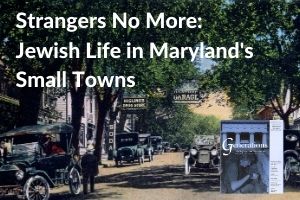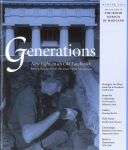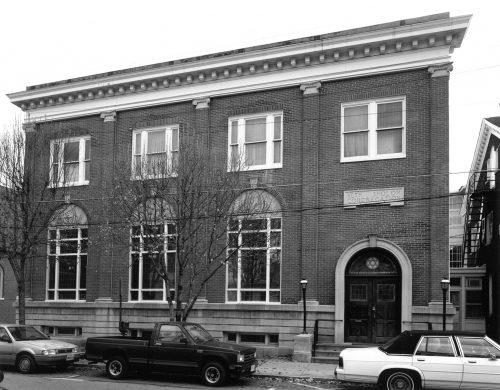Sidebar 1: How to Build a Synagogue, 1917 – 1923

 Part 6 of “Strangers No More: Jewish Life in Maryland’s Small Towns. Missed the beginning? Head there now! Written by Karen Falk, former JMM curator. Originally published in Generations – Winter 2001. If you would like to purchase a hard copy of this issue, please contact our shop, Esther’s Place, at 443-873-5179 or email info@jewishmuseummd.org.
Part 6 of “Strangers No More: Jewish Life in Maryland’s Small Towns. Missed the beginning? Head there now! Written by Karen Falk, former JMM curator. Originally published in Generations – Winter 2001. If you would like to purchase a hard copy of this issue, please contact our shop, Esther’s Place, at 443-873-5179 or email info@jewishmuseummd.org.
Usually, one of the top priorities of a Jewish community is the acquisition of a synagogue building. But communities may have periods of decline as well as growth to consider when planning for their needs, and the advantages of a permanent communal space may not be readily apparent to the leadership of the time. In Frederick, where the Jewish presence dates form the Colonial era and the community had engaged the services of a rabbi as early as 1858, the Frederick Hebrew Congregation was never officially chartered and met for approximately forty years in a series of rented rooms. This venerable community experienced a dangerous period of decline from 1890 to about 1010, when the congregation dwindled and eventually stopped meeting.
Efforts to revitalize the community took several years, and while much of the leadership for this revival came form the established German-Jewish families, we can speculate that another impetus was the arrival of Eastern European families who moved to Frederick during this period.
In 1917, Leo Weinberg, a member of one of Frederick’s oldest Jewish families, prominent Frederick lawyer, and lay reader for the Frederick Hebrew Congregation, spoke at the ground-breaking for Beth Israel, an Orthodox synagogue to be built in the nearby town of Brunswick. Apparently, the example of the tiny Brunswick community inspired Weinberg with a sense of responsibility that he then tried to transmit to the Jews of Frederick. In a Yom Kippur sermon entitled “The Most Acceptable Sacrifice,” he exhorted members of the congregation to pledge contributions to the building of a synagogue in Frederick. As a result, the Beth Sholom Congregation of Frederick was chartered October 1, 1917, and newspapers reported that Mr. David Lowenstein – Weinberg’s uncle – started the building fund with a contribution of $3,000.
Unfortunately, this encouraging beginning was soon stalled, partly by the untimely death of Mr. Lowenstein, By 1921 little progress had been effected towards making the synagogue a reality. Frustrated, the Jewish women of Frederick took matters into their own hands. They united to form a local chapter of the National Council of Jewish Women, whose expressed purpose was to “take such steps and action as will insure the success of the movement of a Synagogue in Frederick, and to this end that Committee be appointed to co-operate with the male members of ‘Beth Sholom’ Congregation, and to rouse them to a realization of their duty, speedily and without delay.”
The women’s determined action met with immediate success: minutes taken on Sunday, April 17, 1921 record the dramatic announcement “that Mr. Leo Weinberg would donate to the Beth Sholom Congregation the two-story building, 37 x 60 ft, situated on West Second Street – provided the congregation would remodel and properly equip same as a Synagogue.” An appeal made to the assembled men and women drew pledges totaling $1,950. The synagogue was completed and dedicated on September 2, 1923.

Continue to Sidebar 2: A Declaration of Faith, 1853, publishing March 4, 2019.

2 replies on “Sidebar 1: How to Build a Synagogue, 1917 – 1923”
I was wondering if you could help me in any way. My name is Gareth Barr and I am trying to find out what became of my great uncle Philip Harwitz. He was Jewish and emigrated to Baltimore I’m 1915. He may have attended a Synagogue there. That is all we really know about him. He was born in Lithuania in 1898, emigrated to Scotland in 1905, then to Baltimore in 1915…Regards..Gareth Barr
Hi Gareth – please email our archivist, Lorie Rombro at lrombro@jewishmuseummd.org and we’ll see if we can find anything!